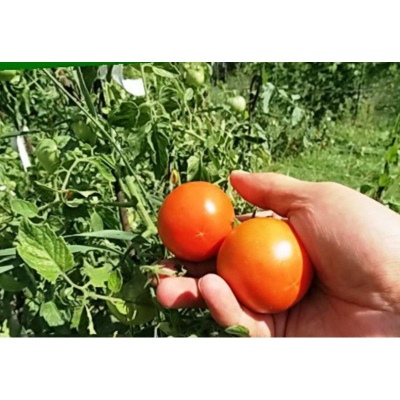
- Category: grade
- Growth type: determinant
- Appointment: universal
- Ripening period: ultra early
- Ripening time, days: 85-95
- Growing conditions: for open ground, for film greenhouses
- Bush size: undersized
- Bush height, cm: about 50
- Ripe fruit color: bright red
- Fruit shape: rounded
Inexperienced gardeners try to plant tomatoes on the plot, which are not very demanding to care for, but at the same time give stable and good yields. These types include an ultra-early tomato variety with the beautiful name Skazka.
Description of the variety
Tomato Skazka is a low-growing plant with a determinant type of growth. A standard bush grows up to 50 cm. The plant is characterized by dense foliage of dark green foliage, thickened branching, an erect strong stem covered with pile, a compact developed root system and simple inflorescences. The first fruit cluster is formed above the 6-7 leaves, where 4-6 berries are tied.
When growing, it is recommended to tie bushes to trellises. To increase the yield, the bushes are formed into 2-3 stems. Bushes do not need pinching, since new shoots are formed very slowly. The purpose of tomatoes is universal, so they are eaten fresh, widely used in cooking, canned, pickled, processed.
The main qualities of the fruit
Tomato Skazka belongs to medium-fruited nightshades, so its weight does not exceed 90-100 grams. The shape of the vegetable is round, sometimes flat-round with a perfectly smooth surface. When ripe, the tomato is evenly covered with a bright red color, and in an unripe state it is light green. The vegetable skin has a high density and gloss, which gives the tomatoes an attractive presentation. Typically, tomatoes grow in the same shape and size. The variety has good transportability, it is resistant to cracking, but keeping quality is poor.
Taste characteristics
Many summer residents and experts note the excellent taste of the Skazka fruit. The flesh of the vegetable is fleshy, dense, with few seeds and very juicy. The taste is dominated by the classic tomato sourness with a light sweet aftertaste, harmoniously combined with a spicy aroma. In the context, the flesh is scarlet without light streaks.
Ripening and fruiting
The variety is ultra-early, which is especially appreciated by summer residents and farmers. From the first shoots to ripe berries on the branches, it takes about 3 months - 85-95 days. The first fruits ripen in mid-June. Ripening of tomatoes is amicable, so you can remove tomatoes with whole fruit brushes. The phase of active fruiting lasts a month.
Yield
The yield indicators of the variety are attractive. On average, subject to standard agricultural practices, 8-10 kg of ripe tomatoes can be removed per 1 m2. The peculiarity is that the yield in the garden is higher than in the greenhouse.
The timing of planting seedlings and planting in the ground
It is recommended to grow a culture in a seedling way. Seed material is sorted and disinfected before planting. Sowing is carried out in March. It is better to plant seedlings in purchased soil. Germination is observed for 5-7 days at the correct temperature and lighting in the room. At the stage of 2 leaves, the bushes dive. A week before transferring the plants to the garden, it is recommended to start hardening the bushes, exposing them to fresh air daily.
It is necessary to transplant seedlings at the stage when the height of the bush reaches 25-30 cm, and the number of leaves reaches 6-9.If there is a possibility of nighttime drops in temperature, then the planted bushes are covered with agrofibre.
If planted in a seedless way, then the sowing of seeds is carried out in late May - early June. Such tomatoes are spiced from early August to mid-October (in unprotected soils).

Growing tomato seedlings is an extremely important process, because it largely depends on whether the gardener can harvest at all. All aspects must be taken into account, from seedbed preparation to planting in the ground.
Landing scheme
The scheme and density of planting seedlings are no less important than the rules for observing crop care. Density indicators for each variety are individual. It is recommended to place from 3 to 5 bushes on each m2. The optimal layout for planting is 40x50 cm.

Growing and care
Fertile and light soils are suitable for tomatoes of this variety. The best is the area where cabbage or legumes were the predecessors. Comprehensive care includes: watering, feeding, garters to supports, forming a bush (optional) and preventing viruses.




A plant needs different micronutrients at each stage of growth. All fertilizers can be divided into two groups: mineral and organic. Folk remedies are often used: iodine, yeast, bird droppings, eggshells.
It is important to observe the rate and period of feeding. This also applies to folk remedies and organic fertilizers.
Disease and pest resistance
Tale tomatoes have immunity to many diseases that nightshades are susceptible to - fusarium wilting, tobacco mosaic virus, late blight and alternaria.


Resistant to adverse weather conditions
Stress resistance in tomatoes is high.They can grow in a shaded area, tolerate insufficient watering, sudden temperature fluctuations, and even short-term frosts.

























































































